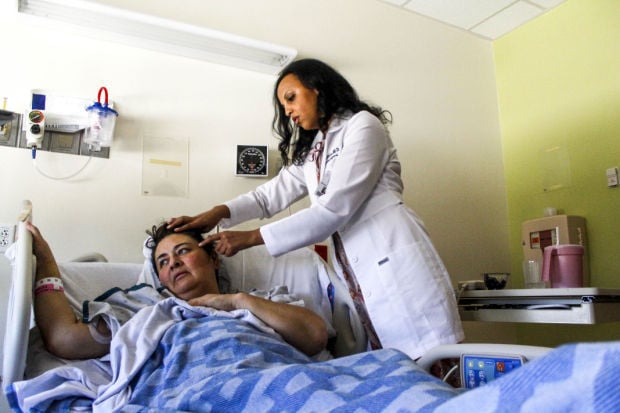The odds were against 44-year-old Red Rock resident Lauren Clifton last month when she became overwhelmed by a sharp headache while getting her son ready for school.
Unbeknownst to Lauren, a six millimeter aneurysm had ruptured in the left side of her brain, causing a subarachnoid hemorrhage that gave her a 50 percent chance of survival.
An aneurysm is similar to a blister that occurs in a weakened spot in a blood vessel. In many cases it’s fine to live with an aneurysm, and millions of Americans do.
Yet when the blood vessels become too weak, sometimes because of the large size of the aneurysm, it ruptures and can be fatal.
Even when people do survive a burst aneurysm, the majority have residual neurological deficits such as difficulty with memory, walking and talking, her neurosurgeon Dr. Emun Abdu said Friday as she checked on Lauren in her room at the Carondelet Neurological Institute, which is part of Carondelet St. Joseph’s Hospital, 350 N. Wilmot Road.
About 30,000 people in the United States suffer a ruptured brain aneurysm every year, which works out to about 100 in the Tucson area annually.
The Carondelet Neurological Institute has an aneurysm support group that meets every Tuesday, but Lauren will have little reason to attend. That she both survived and has no adverse effects was a combination of timing, medical response and luck. She even still has most of her hair.
Lauren, who works as a cashier at Sprouts in Oro Valley, has no risk factors for an aneurysm — she doesn’t smoke, she’s not elderly and she has no family history.
Not surprisingly, neither Lauren nor her family knew what was happening when she became unexpectedly ill the morning of Aug. 27.
The pain began in her right shoulder, and moved through her neck to the left side of her head. Her vision blurred and she called out to her husband, Chris Clifton. Chris found his wife standing up, heavily sweating and saying she did not feel well.
“I had no idea what was going on,” Chris said. “I was trying to wipe the sweat off her forehead and then she started going into a seizure. Her eyes were rolling into the back of her head.”
Chris asked the couple’s 15-year-old daughter to call 911.
Paramedics took Lauren to Northwest Medical Center, and from there she was transferred to the neurological institute at Carondelet St. Joseph’s Hospital.
While some aneurysms can be treated by reaching the ruptured vessel with a catheter through the groin area, Abdu decided that Lauren’s case was too risky for that. So she did brain surgery, temporarily removing a portion of Lauren’s skull.
“Her aneurysm was what you call a wide balloon, so if you try to plug it up from the inside you would plug up the other normal vessels,” Abdu said. “So that would be too dangerous and we took her to surgery instead.”
Lauren remembers very little about that day, though she does recall meeting Abdu before her surgery.
“I remember her saying, ‘You have a 50 percent chance of living’,” Lauren said. “I am very emotional usually but she told me she’d take care of me and it felt like she was family. I prayed to God and the angels and felt that whatever was meant to be was meant to be. Of course, I was also on medication.”
In surgery, Abdu put in a clamp around the burst vessel and made sure none of the other vessels were closed off by doing a CT scan during the operation.
Four days after surgery, Lauren stopped talking and was having trouble moving her right side. A scan showed decreased blood flow going to the left side of her brain. Using a catheter inserted through the groin, Abdu opened up the vessels and Lauren has not had a problem since.
“That’s why someone who has ruptured, you don’t send them home. They have to be cared for in the hospital in case they go into spasm,” Abdu said.
It’s impossible to predict an aneurysm, though Abdu says someone with a family history should see a physician. Aneurysms are three times more common in women, and the risk increases with age. And smoking is like a growth hormone for aneurysms because it weakens the blood vessels, she said.
Often the condition is caught when people are having a workup for something else. “You see it more often in people in their 50s, 60s and 70s,” Abdu said. “The only way you screen it is with all these invasive studies, so you are not going to subject everybody for something that is so rare. That being said, if you have a strong family history of brain aneurysms, you should really talk to your doctor about that.”
Abdu is watching another aneurysm she found on the right side of Lauren’s brain, but she has no plans to treat it at the moment. “There are plenty of aneurysms that I just watch. If it’s three millimeters at a certain location, the chance of bleeding is so low,” Abdu said.
An estimated six million people in the United States have an unruptured brain aneurysm, or one in every 50 people, according to the national Brain Aneurysm Foundation.
When the aneurysm does rupture, Abdu says surgery is needed within 24 hours.
Chris Clifton says friends and family prayed for his wife every day.
“Our youngest is only seven, so he doesn’t really comprehend what happened,” Chris said. “Our 15-year-old knows exactly what is going on. She goes through different waves when she gets really emotional.”
Once she survived the surgery, Chris was ready for Lauren to come back with neurological problems. But it seems life is not going to change as much as he’d thought.





